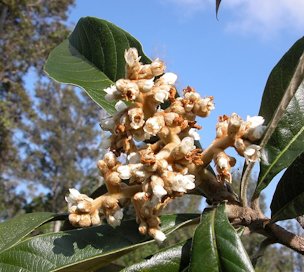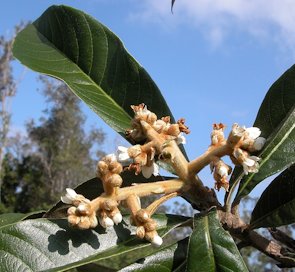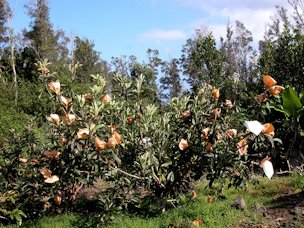From the Twelve
Fruits With Potential Value-Added and Culinary Uses
by Ken Love, Richard Bowen, and Kent Fleming
Loquat
Scientific
name: Eriobotrya
japonica
Family:
Rosaceae
Origin:
China
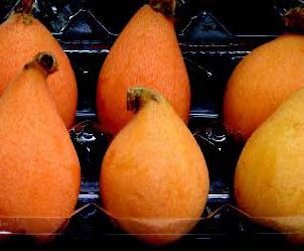
Loquat
is among the first fruits cultivated in Asia and is steeped in ancient
Chinese mythology. For centuries only the Chinese royalty was allowed
to eat the fruit, as it was thought that loquat fruit falling into the
rivers gave the koi, or carp, the strength and desire to swim against
current and up waterfalls and be turned into mythical dragons. The
fruit was introduced from China to Japan as early as 700 AD. In 914 the
first Chinese medical textbook was translated to Japanese and mentioned
how to use loquat to obtain clear lungs. Japanese law books in the
early 900s stated the proper way to present loquat as an offering to
the Shinto gods. In Hawai‘i, loquat is sometimes called pipa
(Chinese) or biwa (Japanese).
Loquat is one of the most popular
fruits in the world. It was grown in Europe in the early 1700s. Spain,
China, and Japan are the world’s largest commercial
producers.
Loquat is also very popular in the Middle East, India, South America,
and South Africa.
The fruit may have been introduced to
Hawai‘i as early as 1787 with Chinese visitors. In 1831, Dr.
F.J.F. Meyen wrote of hearing about a Chinese settlement on Maui prior
to Captain Cooks’ arrival. Loquat was found in the yards of
many
of Hawai‘i’s first Asian immigrants.
Cultivars
There
are over 900 loquat cultivars, and work on the crop is conducted in
many growing areas around the world. In Hawai‘i, common
varieties
are ‘Tanaka’, ‘Gold Nugget’,
‘Mammoth’, ‘Advance’, and
‘Wolf’.
Varieties introduced in the 1990s from Japan include
‘Obusa’, ‘Fusahikari’, and
‘Mizuho’. Many older, wild loquat trees in
Hawai‘i
are thought to be seedlings and produce produce small, inferior fruit.
These trees can be top-worked and grafted with newer varieties. A
seedless variety, ‘Kibou’, was developed in 2003 in
Chiba,
Japan, but it has not yet been released to growers.
Environment
A
subtropical tree, the loquat is well adapted to
Hawai‘i’s
wide range of climates. It prefers upper elevations from 1000 to 5000
feet but is often found grown at lower elevations as an ornamental.
Loquat leaves are sometimes used as fodder or made into tea. The fruit
is susceptible to sunburn at lower elevations. The tree tolerates most
soils with good drainage. Salt spray can cause leaf drop.
Horticulture
Loquat
grows rapidly and needs frequent pruning to keep it managed and
facilitate harvesting. The tree has a shallow root system and may
require irrigation at lower elevations. Trees at the 12 Trees Project
site, at 430 feet elevation, were given 15 minutes of water daily with
a 1⁄2-gallon/hour emitter. The tree is a heavy feeder and
requirements for fertilizer vary greatly depending on location.
Generally, in Hawai‘i, 1⁄2 pound of 6-6-6
fertilizer
applied four times per year to mature trees will ensure good fruit
growth. Loquat can be pruned as an espalier or kept low to the ground.
Multiple branches on new growth are removed, leaving only the top and
bottom branches.
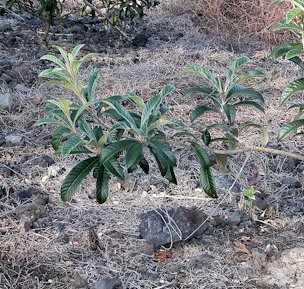
Fig. 1 
Branches can be tied down to keep trees low.
Loquat inflorescences are trimmed to have fewer
flowers (Fig. 2);
after the fruits develop, they are thinned to three or four per
inflorescence and then bagged (Fig.
4).
In
Asia, various techniques are used to produce large fruit with high
quality. As flowers develop, they should be thinned to three bottom
stalks (racemes). Depending on the variety, only three to five fruits
are left on each panicle. The fruit should be covered to protect it
from fruit flies and to slow coloration. Double bags used in Japan
reduce the light reaching the fruit for 80% of fruit development. When
that is reached, the outer bag is removed, leaving the inner bag, which
permits 60% of the light to reach the fruit. Most loquats turn from
green to yellow to light orange when ripe.
In general, loquat
flowers and fruits in Hawai‘i earlier than other growing
locations, from late November through April, with peak production in
January and February.
Bagging loquat fruits is a common practice
throughout Asia; these trees are in South Kona.
Pests and
diseases
Loquat
is a fruit fly host. In addition to the protective wrapping, following
the Hawai‘i Area-Wide Fruit Fly Pest Management Program
recommendations is highly advisable. The tree is also susceptible to
nematodes. Good sanitation should be practiced. Green scale (Coccus
viridis) can also affect the plants. Loquat can be
affected by fire
blight (Erwinia amylovora),
and damaged wood should be removed and
disposed of.
Propagation
Loquat
does not produce true to seed but is easily grafted. Older trees can be
top-worked to change the variety. Scions for grafting should be from
2-year-old wood taken 3–4 months before the tree usually
produces
fruit. Airlayering also works well with loquat.
Harvesting
and yield
Loquat
is very fragile and should be packaged in the field while harvesting.
The fruit should be picked when orange colored. Fruit stems should be
cut close to the fruit and not pulled off. Trees can produce from 100
to 300 pounds of fruit per season. A mature ‘Gold
Nugget’
loquat tree in South Kona at 1800 feet elevation, covering a 20 x 25
foot area at a height of 12 feet, produced 300 pounds of marketable
fruit.
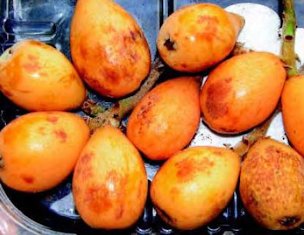
Fig. 6
Bruised and sunburned fruit can be used in value added products such as
jam.
Postharvest
quality
Loquat
can be kept in cold storage for 2 months with little damage. In grocery
stores it should be kept in chilled areas of the produce section to
ensure quality.
Packaging,
pricing, and marketing
Loquat
is packaged differently for hotel and restaurant markets than it is for
grocery or sales at farmers’ markets. The fruits should be
packaged so that they do not touch other fruits, which can cause
bruising and discoloration. Fruit size can vary greatly, and same-sized
fruit should be packaged together. Current wholesale prices in
Hawai‘i depend on fruit size and can range from $2.00 per
pound
to $3.50 a pound or more. Retail prices in Japan for top-quality fruit
can be as high as U.S. $50 for 12 fruits. Loquat is a popular fruit
with hotel chefs, who wish to feature it both as fresh and in various
recipes. Loquat can used in many value-added products. The fruit is the
main ingredient in over 1000 food products in Japan and is often the
featured topic on TV cooking shows.
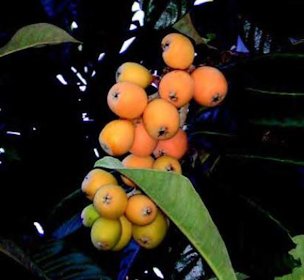
Fig. 7
A "wild" type of loquat
Food uses and
nutrition
Loquat
is a good source of vitamin A; just a few fruits can provide up to half
the recommended daily allowance. Vitamin A is important to visual and
dental health. For thousands of years, the Chinese used extract from
loquat leaves as an important ingredient for lung ailments.
| Nutritional
value per 100 g of edible portion* |
| Moisture |
87
g |
| Calories |
47–168 |
| Protein |
0.43–1.4
g |
| Fat |
0.64–0.7
g |
| Carbohydrates |
11–43.3
g |
| Fiber |
0.83–1.7g |
| Ash |
0.48
g |
| Calcium |
9–70
mg |
| Iron |
0.14–1.4
mg |
| Phosphorus |
11–126
mg |
| Potassium |
185–1216
mg |
| Vitamin
A |
1122–2340
I.U. |
| Ascorbic
acid |
0–3
mg |
| *Values compiled
from various sources. Ranges vary greatly due to degree of ripeness of
fruits tested. |
Recipe
Poha loquat
salsa
Vince Mott and Ann Rothstein
Hawaii Community College - West Hawaii Culinary Arts Program
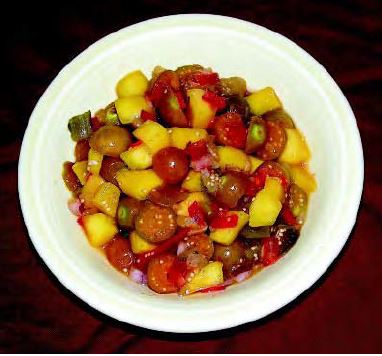
Fig. 8
3 lb poha, cut in half
1 lb loquat, peeled and seeded
3 small mangoes, diced
1⁄4 cup red onion, minced
1 red bell pepper, minced
3 Anaheim chilies, roasted and diced
1 Kona Rangpur lime, juiced
3 slices fresh ginger
Zest of 1 tangerine
2 cups sake
6 cups water
1 T lilikoi puree
1 T olive oil
1 pinch salt
Optional: 1⁄4 cup cilantro
Cook
peeled loquats in simple syrup (1 cup water and 1 cup sugar), then cut
and dice. Save syrup to flavor salsa, if desired. Mix loquat with other
cut fruit and other ingredients. Add additional lime juice to taste.
About the
Twelve Fruits With Potential Value-Added and Culinary
Uses Project
Back to
Loquat
Page
|
© 2007, University of Hawai'i
|
Bibliography
Love,
Ken, et al. "Twelve
Fruits With Potential Value-Added and Culinary
Uses." University of Hawai'i at Mānoa, College of
Tropical Agriculture and Human Resources, 2007, www.hawaiifruit.net/12trees.html.
Accessed 17
Mar. 2016.
Photographs
Love, Ken. "Loquat, 2007, Twelve Fruits With Potential Value-Added and Culinary
Uses." HawaiiFruit.net, University of Hawai'i at Mānoa, College of Tropical
Agriculture and Human
Resources, www.hawaiifruit.net/12trees.html.
Accessed 17
Mar. 2016.
Published 17 Mar. 2016 LR
|



